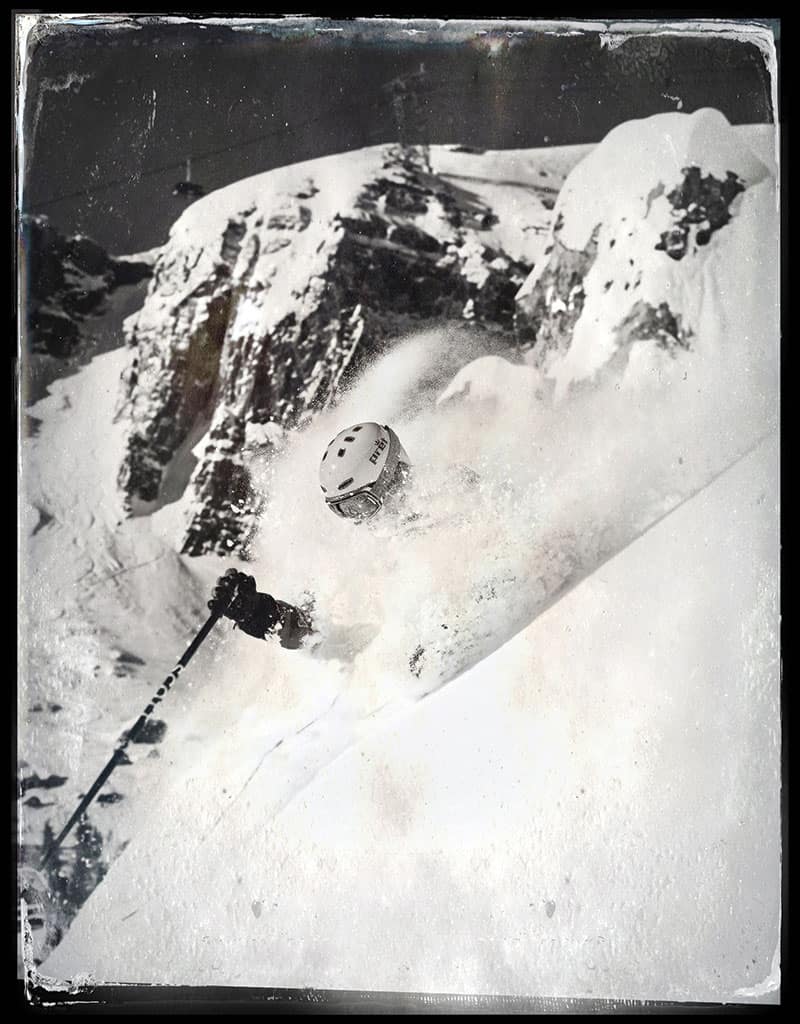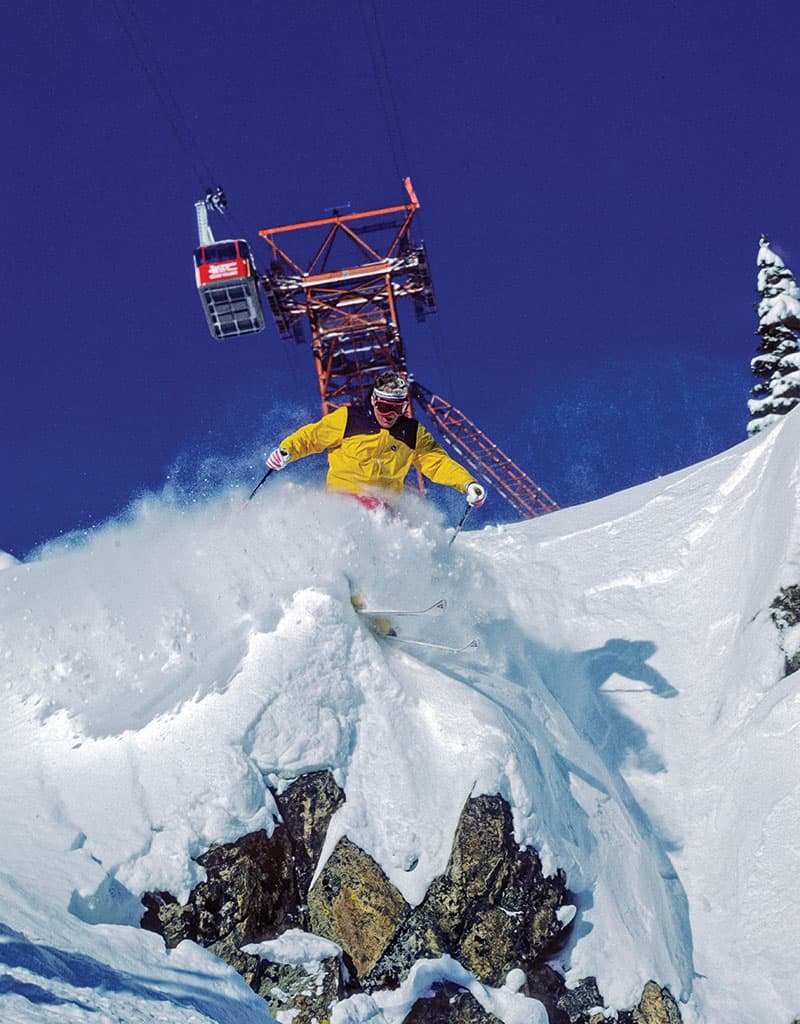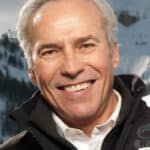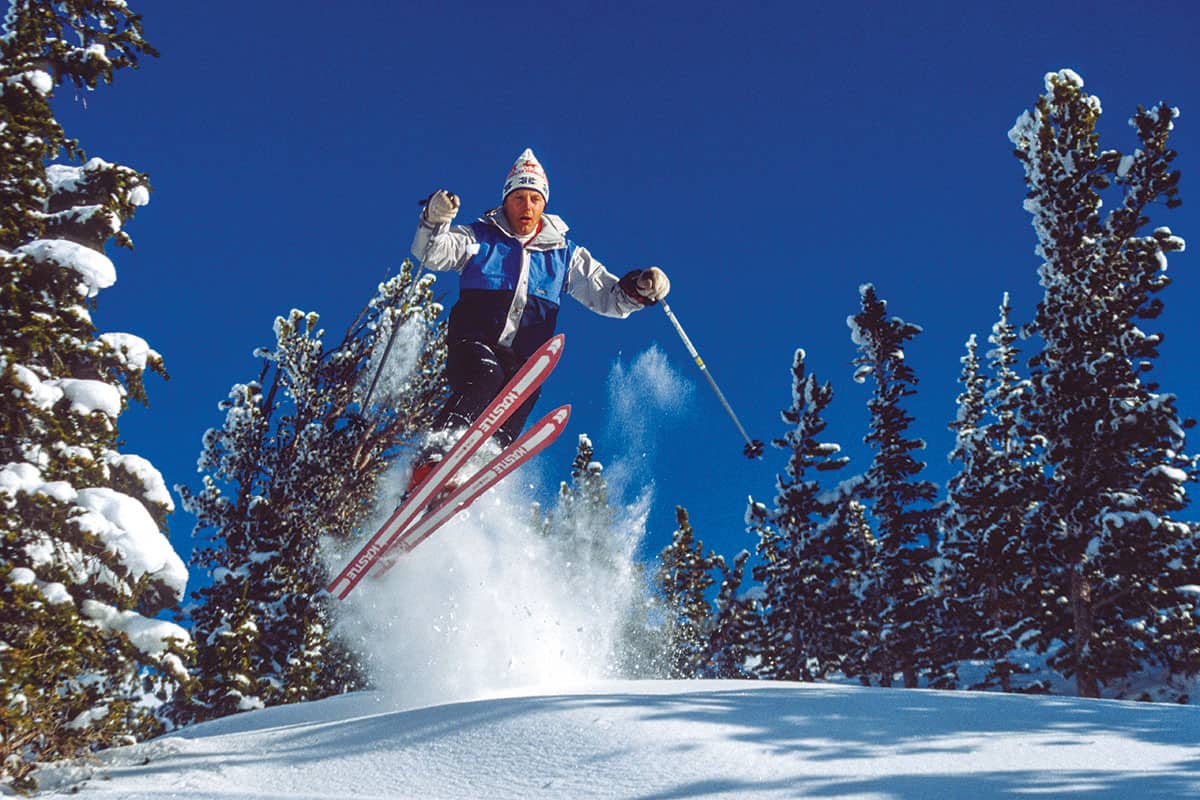Read The
Current Issue
Wild Child
At fifty years old, Jackson Hole Mountain Resort has grown up while staying true to its founders’ visions.
By the Editors

Since its aerial tram first took skiers to the 10,450-foot summit of Rendezvous Mountain just outside the boundary of Grand Teton National Park in December 1965, Jackson Hole Mountain Resort has been equally loved and feared by extreme skiers and snowboarders for its challenging terrain, 4,139 feet of vertical, and powder. As recently as a decade ago, though, skiers and riders at every other level just plain feared it. The majority of the resort’s runs were black diamond. Grooming wasn’t a priority. The only thing in shorter supply than intermediate terrain was base-area amenities. Want to pamper yourself with an afternoon at the spa? Good luck. “It was clear Jackson Hole was high-testosterone skiing,” says resort president Jerry Blann. “You found a resort with the terrain we have, you hire an Olympic champion to be your ski school director, and you attract a certain type of person.”
This season, JHMR turns fifty and is now as family friendly and intermediate- and amenity-rich as most any destination resort. The transition is almost unbelievable, but not quite. What is unbelievable is that the resort has gone from punishing to polished without sacrificing its soul. “We’ll never be a megaresort or pure vanilla,” Blann says. “We’ve got a Four Seasons and a hostel and everything in between. We’ll never be all things to all people. We have our mountain, and we’ll be us.” Jackson’s “us” is “a small town where everyone helps everyone else out,” says Jackson native and former U.S. and World Freeskiing champion Jess McMillan. “It may feel like this huge resort, but at the same time everyone will say, ‘Hello.’ It still has that small-town camaraderie to it.” This year, as a birthday present to itself, JHMR also has a new high-speed quad. The Teton Lift, which accesses intermediate and advanced terrain previously only available if you had the strength and will to hike to it, is the best kind of gift: one that we all get to enjoy. — The Editors

A Short History of JHMR
Alex Morley moved to Jackson Hole to be a ski bum. At Snow King. “I didn’t move to Jackson to build a ski area but to be a ski bum,” Morley said in an interview a few months before his death in November. It was the 1960s when Morley bought land and built a house on Antelope Flats in Grand Teton National Park. “I looked across the valley at the Tetons and thought, ‘Some of those mountains are better than Snow King by ten times!’ ”
Paul McCollister, a retired (at age forty-two) advertising executive, lived about one mile from Morley. McCollister had a similar view from his home as Morley did and had the same thought about the Tetons compared to Snow King. “We formed a partnership,” Morley said. “I first thought about putting the ski resort on Buck [Mountain], but we realized pretty quickly that was a bad idea. It was too tough, and it was inside the park.”
The two men turned their attention to Rendezvous Mountain, just outside the park’s southern boundary. “We put skins on and were the first to climb Rendezvous,” Morley said. They thought they might be onto something but hired University of Denver ski coach and noted ski area consultant Willy Schaeffler to study the area for its potential. “All ski areas in America at the time were on north slopes,” Morley said. Rendezvous and Apres Vous mountains faced east and south. “We worried they’d ice up,” Morley said.
For three winters, the men packed out a slope on Apres Vous Mountain that “the sun really hit.” They’d bring up skiers—all friends—with a Kristi snowcat to test conditions. It never got icy. The men still wanted Schaeffler’s full report, though. “Once we heard from Willy, that set us off,” Morley said. “He wrote this would be one of the best ski resorts in the world. We formed a corporation and got to work. We got a lease from the forest service that today would be flat-out impossible. You couldn’t build Jackson Hole today.”
Because the valley was considered an economically depressed/distressed area at the time—in the winter, about half of the valley’s population was on welfare—the corporation got a low-interest government development loan. Morley also turned to his friend, Wyoming governor Cliff Hansen, to get loans from the state. “Paul didn’t have much money, and I had a little money,” Morley said. “We put in what we could personally, but we needed more.”
“From the beginning, it was always intended to be an international ski area,” he said. “We planned on bringing people from everywhere.”
Even though there was only one existing aerial tram in the country at the time—at Cannon Mountain in New Hampshire, and it was much shorter—McCollister and Morley decided to build one at Jackson Hole. They didn’t opt for a tram because of skiers, however; Morley was thinking ahead to summer visitors. “Summertime in Jackson Hole back in those days was booming. I got to thinking summer would be our biggest business and wanted something that would attract tourists,” he said. “Gondolas didn’t exist yet, and I knew people wouldn’t want to sit on a chairlift for that long. A tramway was the obvious thing.” They hired Canadian engineer Bob McClellan to design it. “We knew it’d be good for winter, too. It’s fast. And it worked; it really did. And that’s when the trouble started.”
“We were a brand new ski area, but where were the skiers?” asked Morley. “They stayed away.” Jackson Hole had the unfortunate timing to open in 1965, shortly after Vail in 1962. “Vail was huge competition,” Morley said. “It was easy access. People flocked there.”
“Rendezvous Mountain is a beautiful mountain, and it is something that not many ski resorts—then or now—were: steep. At the beginning, ‘steep’ was not a good word. We’d go to ski shows in New York, and when people learned we were from Jackson Hole, they’d say, ‘Oh that’s the one that is steep and cold.’ The steepness of the mountain worked against us.” — Pepi Stiegler, Olympic medalist (silver in 1960 and gold and bronze in 1964) and JHMR ski school director from its opening until 1995
“Building [Jackson Hole], I had the greatest time. I loved every minute of it,” Morley said. “It was running it that was hard. Paul was a salesman who could sell you anything. I was the businessman who raised the money and did the building. But I wasn’t a manager. I wanted to hire someone, but we didn’t have the money.”
Sometimes the resort didn’t have money to pay the employees it did have. “I had a horrible time keeping it together,” Morley said. When they couldn’t make payroll, Morley called his friend, Dr. King Curtis. “I asked to borrow $250,000, which was like $2 million today,” Morley said. “I did that again and again. I’d make the payroll for a few weeks. And then we’d sell a lot, or I’d go back to King. We also sold lifetime passes for practically nothing.”

Several years after opening, the resort still struggled. Jackson Hole was just too difficult to get to. “My wife told me that if I didn’t quit, I was going to die,” Morley said. “It was that stressful. I sold my interest in the resort back to the [Jackson Hole] Ski Corporation.”
McCollister, who died in 1999, continued to run the resort until selling it to the Kemmerer family in 1992. “It’s amazing Paul kept it going as long as he did,” Morley said. “He had a vision, but the economics became a staggering problem.”
“We have a vision for this place that wants to be about quality, not quantity. We don’t want to be Vail or Aspen. We love those guys, but that’s not us.” — Jerry Blann, JHMR president
Since buying the resort, the Kemmerers have invested upwards of $138 million in new lifts, expanding terrain and snowmaking, grooming, and on-mountain amenities. They built the Bridger gondola and Marmot lift; replaced the Apres Vous, Casper, and Teewinot lifts and, in their single biggest expenditure, the aerial tram; and this winter they added the Teton Lift.
As the skiing has improved, so have the offerings at the base area. The first spa appeared in 2000, inside the Snake River Lodge & Spa, which at the time was the most luxurious overnight option in Teton Village. Three years later, Jackson Hole became the first ski resort in the world to get a Four Seasons. Then came the world’s first LEED Silver certified boutique hotel, Hotel Terra.
“Luckily the Kemmerers came along,” Morley said. “Paul and I had a vision when we started building it, but never like it is today. That is beyond my belief.”

Cofounder Alex Morley’s Great Run
You know someone has lived an incredible life when cofounding Jackson Hole Mountain Resort isn’t the most interesting, or even the second most interesting, thing they’ve done. Paul McCollister gets much of the credit for creating JHMR, but today’s skiers should direct some serious thanks to Alex Morley, too. Everyone, skier or not, should be in awe of the way Morley, who died this fall, lived and loved life.
Meeting Morley for the first time this past summer at a pancake place not far from his home in Bend, Oregon, where he has lived since 1994, I guessed he was in his mid-seventies. He arrived in a canary yellow Toyota FJ Cruiser. Emblazoned on each side was a photo of him carving on a groomer. Brighter than Morley’s Toyota were his eyes, twinkling and bluer than even Paul Newman’s.
We were both through our pancakes before I realized my estimate of Morley’s age was off. He mentioned he was married, to Rachel, for sixty-five years. Assuming he and Rachel married young, I revised my estimate to eighty-three years old. Several minutes later, in passing, he mentioned he flew 237 combat missions in World War II, about as many as any pilot who had lived through that war. My estimate was way off.
Morley was ninety-six. He skied until he was ninety-two.
Morley died of pancreatic cancer in November, just short of his ninety-seventh birthday. In September, sitting with him in his home overlooking the Deschutes River, he talked about the five lives he had lived.
“My first life had nothing to do with any of the subsequent ones,” he said. “I was an Air Force paratrooper pilot. I was blind lucky to survive 237 combat missions.”
One of the missions Morley flew has been depicted in movies as well as in the 2015 book, Rescue at Los Baños: The Most Daring Prison Camp Raid of World War II.
Morley’s second life was as a contractor/developer in his hometown of Cheyenne. Morley pounded nails starting in high school and through college, where he was also in ROTC. When he returned home from the war, Morley decided he would be a developer and builder. The company he founded built five hundred houses for soldiers on Francis E. Warren Air Force Base. A bad deal with the government eventually soured Morley on building, and he decided to be a ski bum, which was life No. 3.
Morley first skied at age eight, on a small hill outside Cheyenne on skis he made in his basement.
Morley debated between Aspen, Switzerland, or Jackson Hole, where he kept a boat on Jackson Lake in the summer. “Aspen was starting to get a drug culture, and, in Switzerland, you’d always be a foreigner. They didn’t accept people unless they were born there. I was born in Wyoming,” he said. And so, Jackson Hole—home to Wyoming’s first ski resort, Snow King—it was. Morley moved to the valley with his family in 1961.
Life No. 4, living on Orcas Island, Washington, and spending most of his time sailing with Rachel and his family, started after he sold his interest in the ski area to Paul McCollister. It lasted until he moved to Bend.
Morley’s life in Bend consisted of taking care of Rachel, who died in 2006, working to develop a ski area on the part of Mount Jefferson on the Warm Springs Indian Reservation, and adventuring with friend Helen Vandervort. “I was fortunate to have had so many experiences,” he said. “What a ride it has been.” — Dina Mishev
2 Skiers, 1 Resort

Jerry Blann started working at Oregon’s Mt. Bachelor, where his father was general manager, when he was ten. “Dad said, ‘I need some help and you’re it,’ ” Blann recalls. “It was great and what got me started.” Blann went on to race at the University of Denver on a skiing scholarship and then got into ski-area management after graduating. Before taking the job of president of JHMR in 1995, Blann was president and CEO of Aspen Skiing Co.
PRESIDENT
Favorite Run
When we get new snow, I’m up on the tram and then I stay on that side of the resort. I love R Trail and Bivouac. When they’re right, the Hobacks can’t be beat. Just in that section we’ve got more terrain than many ski areas.
Overcrowding?
We actually scaled down the mountain’s approved capacity. It was 10,500. The master plan we did reduced it to 7,690 at build-out, though.
Best Aprés Ski Spot
Ascent Lounge at the Four Seasons was a usual, but since the Spur was redone, that’s my spot.
Favorite Ski Day
Any powder day in the Hobacks
Learned Wisdom
No matter the intermediate terrain we add, Jackson will always attract adventuresome families. Even in our Kids Ranch, they’re out skiing. It’s not day care; we’re getting kids out. It is that ethos that comes along with the resort.

SPENCER RANK MOVED to Jackson in 1999. “I came for one winter and here I am sixteen years later,” he says. Rank, founder of Teton Art Services, “gravitated to Jackson because of the open boundaries and continuous vertical. I also picked it because it was difficult to get to. That’s now changed, but I’m still ruined for most every other resort I go to.” We had Blann and Rank sit down and chat about the resort they both love.
(former) SKID
Favorite Run
Rendezvous Bowl to Cheyenne Bowl to Sparky’s Traverse to North Hoback. Get that top to bottom on a powder day and basically it’s better than a day of heli-skiing, and you get it with a ski pass.
Overcrowding?
Most of the vacationing skiers who come don’t use the same terrain I do. My beef is too many college kids moving here every winter, trying to prove themselves.
Best Aprés Ski Spot
Village Cafe and Spur. I rue the loss of the VC—this is our first season without it. Don’t get me started on missing the Boom Boom Room.
Favorite Ski Day
December 10, 2012. You could ski any aspect and the wind kept blowing it in.
Learned Wisdom
The people who just watch the number on the snow report sometimes miss out. The snow report doesn’t tell everything.

Pepi Stiegler’s Story
Josef “Pepi” Stiegler, ski school director from the resort’s opening until 1995, has much to do with what Jackson Hole’s Mountain Sports School looks like today. But Stiegler wasn’t the first (or second) choice of resort cofounders Paul McCollister and Alex Morley for the position.
The job was first offered to American ski star Buddy Werner. Werner, a native of Steamboat Springs, Colorado, accepted the post but died in an avalanche near St. Moritz, Switzerland, the season before Jackson Hole opened. Jackson Hole next approached Austrian Othmar Schneider, who was the ski school director at Boyne Mountain in Michigan. Schneider did not accept the position but did recommend former teammate and Olympic medalist—silver at the 1960 Games and gold and bronze in 1964—Stiegler. “For me, it was a big deal to take on a ski school that was originally offered to a great American skier,” Stiegler, now seventy-eight, says. “I felt very privileged.” Prior to Jackson Hole, Stiegler had never directed a ski school.
“The first thing I had to do was separate the ski bums who only wanted to get on the staff so that they could get a free ride on the tram,” Stiegler says. “They weren’t professional, and I had to sort those guys out. I was a disciplinarian.” While finding qualified instructors was a challenge—Stiegler initially ended up with a staff of mostly Austrians—finding students in the early days was not. “The ski school meeting place was right near the [bottom of] the aerial tram and Apres Vous lift,” Stiegler says. “We took advantage of people being intimidated to some degree.” Even with a ready supply of students, though, “The ski school didn’t make any money for six years,” Stiegler says. “I look at it today and it is so big. It is unbelievable.” — D.M.




